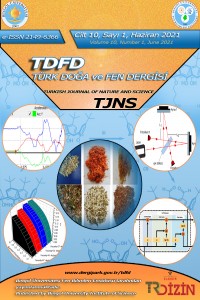Abstract
Elektrik enerjisinin daha verimli bir şekilde kullanılabilmesi güç sistemlerinin takip ve analizi ile mümkündür. Üretim ve tüketim tarafında yer alan sistem bileşenlerinin doğru tanımlanması durumunda, güç sistemlerinin karakteristik davranışları ve muhtemel tepkileri belirlenebilmektedir. Ayrıca, yük atma ve yük kaydırma gibi güç kontrol uygulamalarında elektrikli aletlerin yük modellerine göre sınıflandırılması gerekmektedir. Bu çalışmada, tüketim tarafında yer alan elektrikli cihazlar aktif ve reaktif güç tüketimleri referans alınarak sınıflandırılmaktadır. Örnek elektrikli cihaz olarak evlerde ve ofislerde sıkça kullanılan 5 adet farklı tüketim karakteristiğine sahip cihaz seçilmiştir. Sınıflandırma için son zamanlarda yaygın olarak kullanılan makine öğrenmesi algoritmaları karşılaştırılmış ve en iyi sonuçları veren beş algoritmanın performansı analiz edilmiştir. Elde edilen sonuçlara göre en yüksek doğruluk oranını en kısa eğitim süresinde veren yöntem destek vektör makineleri olmuştur.
References
- [1] Aydın Ü, Peker H, Gönülalan UA. 7. Petrol Sektörü. In: Türkiye’nin Enerji Görünümü. 2000. p. 161–214
- [2] Hung Y, Michailidis G. Modeling and Optimization of Time-of-Use Electricity Pricing Systems. IEEE Transactıons On Smart Grıd. 2019; 10(4): 4116-4127
- [3] Weiss M, Staake T, Guinard D, Roediger W. eMeter: An interactive energy monitor. In: UbiComp. 2009. p. 3–4. [4] Neenan B, Robinson J, Boisvert RN. Residential electricity use feedback: a research synthesis and economic framework. Electric Power Research Institute (EPRI), 2009.
- [5] Abeykoon V, Kankanamdurage N, Senevirathna A, Ranaweera PS, Udawapola R. Real Time Identification of Electrical Devices through Power Consumption Pattern Detection. 2016 First International Conference on Micro and Nano Technologies Modelling and Simulation, March 2016. Kuala Lumpur, Malaysia. p. 1-3. doi: 10.1109/MNTMSim.2016.13.
- [6] Kavrar Ö, Yılmaz B. Enerji Yönetiminde Faaliyet Tabanlı Maliyetleme Modeli: Bir Üretim İşletmesinde Uygulama. Muhasebe ve Finansman Dergisi. 2019; (83): 85-110. [7] Jing-xiao Z, Hui L, Li B. Life cycle influnce mechanism of energy-saving chain management on energy-saving building construction. 2010 International Conference on Mechanic Automation and Control Engineering, Wuhan, 2010. p. 1904-7. doi:10.1109/MACE.2010.5536595
- [8] D’Alessandro S, Tonello AM, Monacchi A, Elmenreich W. Home energy management systems: Design guidelines for the communication infrastructure. In: ENERGYCON 2014 - IEEE International Energy Conference. IEEE; 2014. p. 805–12.
- [9] Krishna Prakash N, Prasanna Vadana D. Machine Learning Based Residential Energy Management System. In: 2017 IEEE International Conference on Computational Intelligence and Computing Research, ICCIC 2017. IEEE; 2018.
- [10] Zekić-Sušac M, Mitrović S, Has A. Machine learning based system for managing energy efficiency of public sector as an approach towards smart cities. International Journal of Information Management [Internet]. 2020;(March 2019):102074. Available from: https://doi.org/10.1016/j.ijinfomgt.2020.102074.
- [11] UĞUZ S, ÇAĞLAYAN N, ORAL O. PV Güç Santrallerinden Elde Edilecek Enerjinin Makine Öğrenmesi Metotları Kullanılarak Tahmin Edilmesi. Uluslararası Mühendislik Araştırma ve Geliştirme Derg [Internet]. 2019;11(3):769–79. Available from: http://dx.doi.org/10.29137/umagd.514933.
- [12] Wu X, Zhu X, Wu GQ, Ding W. Data mining with big data. IEEE Transactıons On Knowledge And Data Engıneerıng. 2014;26(1):97–107. doi: 10.1109/TKDE.2013.109.
- [13] Lin M, Wang H, Xu Z, Yao Z, Huang J. Clustering algorithms based on correlation coefficients for probabilistic linguistic term sets. International Journal of Intelligent Systems. 2018;33(12):2402–24.
- [14] Rygielski C, Wang JC, Yen DC. Data mining techniques for customer relationship management. Technology in Society.2002; 24(4):483–502.
- [15] Wang XZ, He Q, Chen DG, Yeung D. A genetic algorithm for solving the inverse problem of support vector machines. Neurocomputing. 2005;68(1–4):225–38.
- [16] BUDAK H. Özellik Seçim Yöntemleri ve Yeni Bir Yaklaşım. Süleyman Demirel Üniversitesi Fen Bilim Enstitüsü Derg. 2018;22(Özel):21-31.
- [17] Ladha L, Deepa T. Feature Selection Methods And Algorithms. Int J Comput Sci Eng. 2011;3(5):1787–97.
- [18] Güner A, Alçin ÖF, Şengür A. Automatic digital modulation classification using extreme learning machine with local binary pattern histogram features. Meas J Int Meas Confed. 2019;145:214–25.
- [19] Huang D, Shan C, Ardabilian M, Wang Y, Chen L. Local binary patterns and its application to facial image analysis: A survey. IEEE Trans Syst Man Cybern Part C Appl Rev. 2011;41(6):765–81.
- [20] Huang D, Shan C, Ardabilian M, Wang Y, Chen L. Local binary patterns and its application to facial image analysis: A survey. IEEE Trans Syst Man Cybern Part C Appl Rev. 2011;41(6):765–81.
- [21] Cortes C, Vapnik V. Support-vector networks. Mach Learn. 1995;20:273–97. https://doi.org/10.1007/BF00994018.
- [22] Huang S, Aydin M, Lipo TA. TORUS concept machines: Pre-prototyping design assessment for two major topologies. Conf Rec - IAS Annu Meet (IEEE Ind Appl Soc. 2001;3(August):1619–25.
- [23] Yang L, Xu Z. Feature extraction by PCA and diagnosis of breast tumors using SVM with DE-based parameter tuning. Int J Mach Learn Cybern. 2019;10(3):591–601.
- [24] Zhang J, Hou Q, Zhen L, Jing L. Locality similarity and dissimilarity preserving support vector machine. Int J Mach Learn Cybern. 2018;9(10):1663–74.
- [25] Chen SG, Wu XJ. A new fuzzy twin support vector machine for pattern classification. Int J Mach Learn Cybern. 2018;9(9):1553–64.
- [26] Wang XZ, Lu SX, Zhai JH. Fast fuzzy multicategory SVM based on support vector domain description. Int J Pattern Recognit Artif Intell. 2008;22(01):109–20.
- [27] Üzen H, Hanbay K. Yaya Özellik Tanıma için LM Filtre Temelli Derin Evrişimsel Sinir Ağı. J Polytech. 2019;0900(3):605–13.
- [28] Karabiber A, Alçin ÖF. Short Term PV Power Estimation by means of Extreme Learning Machine and Support Vector Machine. 7th International Istanbul Smart Grids and Cities Congress and Fair, ICSG 2019 - Proceedings. 2019. p. 41–4.
Details
| Primary Language | Turkish |
|---|---|
| Subjects | Engineering |
| Journal Section | Articles |
| Authors | |
| Publication Date | June 25, 2021 |
| Published in Issue | Year 2021 Volume: 10 Issue: 1 |
Cite
Cited By
Konutlardaki Elektrikli Cihazların Evrişimli Sinir Ağı ile Otomatik Sınıflandırılması
Gazi Üniversitesi Fen Bilimleri Dergisi Part C: Tasarım ve Teknoloji
https://doi.org/10.29109/gujsc.1119624
Fake News Detection with Machine Learning Algorithms
Celal Bayar Üniversitesi Fen Bilimleri Dergisi
https://doi.org/10.18466/cbayarfbe.1472576
This work is licensed under the Creative Commons Attribution-Non-Commercial-Non-Derivable 4.0 International License.

